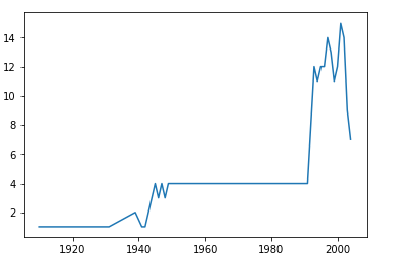Pandas Datetime: Create a plot to present the number of unidentified flying object (UFO) reports per year
Pandas Datetime: Exercise-7 with Solution
Write a Pandas program to create a plot to present the number of unidentified flying object (UFO) reports per year.
Sample Solution :
Python Code :
import pandas as pd
df = pd.read_csv(r'ufo.csv')
df['Date_time'] = df['Date_time'].astype('datetime64[ns]')
print("Original Dataframe:")
print(df.head())
print("\nPlot to present the number unidentified flying objects (ufo) found year wise:")
df["Year"] = df.Date_time.dt.year
df.Year.value_counts().sort_index().plot(x="Year")
Sample Output:
Original Dataframe:
Date_time city ... latitude longitude
0 1910-06-01 15:00:00 wills point ... 32.709167 -96.008056
1 1920-06-11 21:00:00 cicero ... 40.123889 -86.013333
2 1929-07-05 14:00:00 buchanan (or burns) ... 43.642500 -118.627500
3 1931-06-01 13:00:00 abilene ... 38.917222 -97.213611
4 1939-06-01 20:00:00 waterloo ... 34.918056 -88.064167
[5 rows x 11 columns]
Plot to present the number unidentified flying objects (ufo) found year wise:

Python Code Editor:
Have another way to solve this solution? Contribute your code (and comments) through Disqus.
Previous: Write a Pandas program to get all the sighting years of the unidentified flying object (ufo) and create the year as column.
Next: Write a Pandas program to extract year, month, day, hour, minute, second and weekday from unidentified flying object (UFO) reporting date.
What is the difficulty level of this exercise?
Python: Tips of the Day
Find current directory and file's directory:
To get the full path to the directory a Python file is contained in, write this in that file:
import os dir_path = os.path.dirname(os.path.realpath(__file__))
(Note that the incantation above won't work if you've already used os.chdir() to change your current working directory, since the value of the __file__ constant is relative to the current working directory and is not changed by an os.chdir() call.)
To get the current working directory use
import os cwd = os.getcwd()
Documentation references for the modules, constants and functions used above:
- The os and os.path modules.
- The __file__ constant
- os.path.realpath(path) (returns "the canonical path of the specified filename, eliminating any symbolic links encountered in the path")
- os.path.dirname(path) (returns "the directory name of pathname path")
- os.getcwd() (returns "a string representing the current working directory")
- os.chdir(path) ("change the current working directory to path")
Ref: https://bit.ly/3fy0R6m
- New Content published on w3resource:
- HTML-CSS Practical: Exercises, Practice, Solution
- Java Regular Expression: Exercises, Practice, Solution
- Scala Programming Exercises, Practice, Solution
- Python Itertools exercises
- Python Numpy exercises
- Python GeoPy Package exercises
- Python Pandas exercises
- Python nltk exercises
- Python BeautifulSoup exercises
- Form Template
- Composer - PHP Package Manager
- PHPUnit - PHP Testing
- Laravel - PHP Framework
- Angular - JavaScript Framework
- Vue - JavaScript Framework
- Jest - JavaScript Testing Framework
